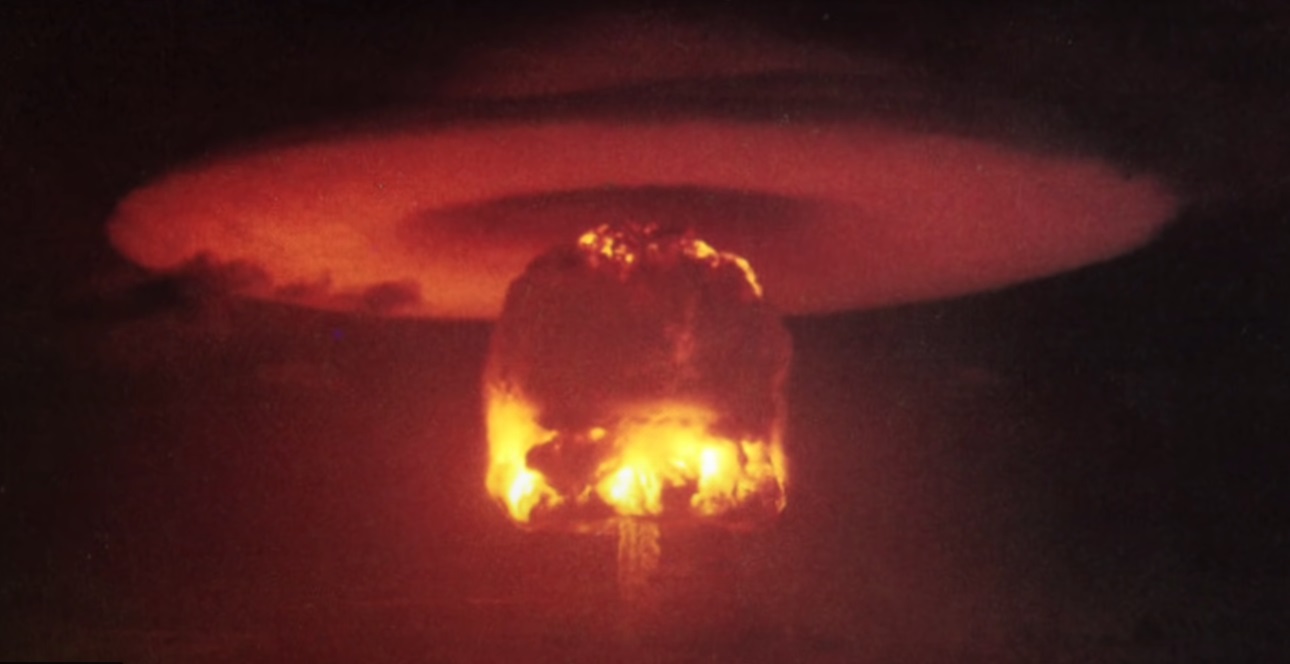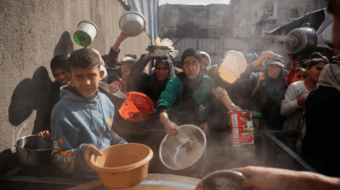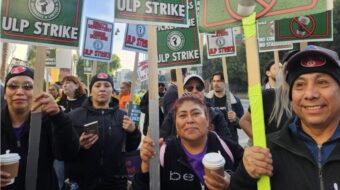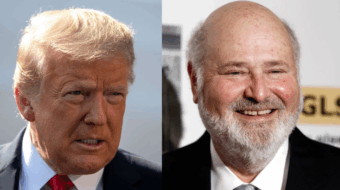
LIVERMORE, Calif. – “They don’t want peace. Why? Because peace doesn’t make money.” Those words were spoken here at the recent demonstration against the production of thermonuclear weapons at Livermore Labs.
As peace activists gathered around the world to commemorate the 79th anniversary of the U.S. nuclear bombings of Hiroshima and Nagasaki, honoring the hundreds of thousands killed or severely injured and demanding the weapons be abolished, over 100 demonstrators assembled at the West Gate of Lawrence Livermore National Laboratory, one of two locations designing and developing every nuclear weapon in the U.S. arsenal.
Standing before a banner proclaiming “Back from the Brink: The Imperative of Nuclear Abolition,” Scott Yundt, executive director of Tri-Valley Communities Against a Radioactive Environment (Tri-Valley CAREs), which monitors nuclear weapons and environmental clean-up activities with a special focus on Livermore Lab, told demonstrators that the 9,500 workers there are busier now than at any time since the end of the Cold War. “And while we are contemplating a world where what happened 79 years ago never happens again,” he said, “inside the fence, they are contemplating total nuclear annihilation.”
Among the many nuclear warhead programs the lab is working on are the W80-4 warhead for the long-range standoff cruise missile and the W87-1 warhead for the new Sentinel intercontinental ballistic missile.
“These thermonuclear weapons are exponentially more powerful than the bombs we dropped on Hiroshima and Nagasaki,” Yundt said, and they “are being loaded with new, never-before-developed systems, technologies and capabilities that make these civilization-ending weapons more flexible and usable for a wide array of potential missions for the Department of Defense.”

The W87-1 warhead is the first entirely new warhead to be designed since the Cold War ended, with a new plutonium bomb core, or pit, and surrounding components substantially different from any other warhead that’s been tested, Yundt said. Four hundred new ICBM missiles are planned, with two of the new warheads on each missile. Pit production will expand at two other U.S. nuclear weapons sites, Los Alamos National Laboratory in New Mexico and Savannah River Site in South Carolina.
Tri-Valley CAREs and other monitor groups are suing the National Nuclear Security Administration for failing to adequately analyze the environmental impacts of plutonium pit production. They say the NNSA failed to include extensive work at Livermore Lab and didn’t sufficiently examine the increase in nuclear waste or the risks from shipping plutonium across the country on highways.
Yundt said $30 billion of the $895 billion the Biden Administration requested for national defense in fiscal 2025 is slated for nuclear weapons and related programs. Some $2.5 billion of that will come to Livermore Lab, with most of it for nuclear weapons. Overall, modernizing nukes is slated to cost the U.S. more than $2 trillion over the next three decades: “It’s all part of an ever-spiraling nuclear weapons-industrial complex and budget that overshadows those of all other countries by orders of magnitude and shows no signs of slowing down.”
Maylene Hughes, staff member with Physicians for Social Responsibility Los Angeles and the organization’s liaison to the national Back from the Brink campaign, said the stories of those who perished and who survived the Hiroshima and Nagasaki bombings “compel us to act so that such horrors are never repeated.”
Besides making the world a safer place for all, Hughes said, “The billions of dollars currently invested in the nuclear complex could and should be redirected to address community needs that are far more pressing to the lives of everyday people. Imagine if we invested those resources in healthcare, housing, education, and the fight against poverty?”
Back from the Brink was founded in 2017, shortly after the United Nations Treaty on the Abolition of Nuclear Weapons was adopted. Its aim is to build public demand and political will for nuclear abolition. Its mission is “clear and urgent, to lead negotiations among nuclear-armed states for multilateral, verifiable and time-bound agreements to eliminate nuclear weapons globally.”
Hughes said Back from the Brink also calls on the U.S. government to undertake “common sense policy solutions” to help reduce the risk of nuclear war right now:
- Renounce the option of using nuclear weapons first,
- End the sole unchecked authority of any U.S. president to launch a nuclear attack,
- Take U.S. nuclear weapons off hair-trigger alert, and
- Cancel plans to replace the entire U.S. arsenal with enhanced nuclear weapons.
She said local, community-based organizing is the heart of the campaign’s work, with “everyday people … who want to make a difference” united to speak out and act against the threat of nuclear weapons.
Among Back from the Brink’s achievements: over 80 municipalities, counties, and state bodies, including major cities like Boston, Chicago, San Francisco, and Los Angeles, have adopted resolutions supporting the campaign’s policy platform. “Every time a city council, county board or state legislature passes one of these resolutions,” Hughes said, “they are sending a clear message to Washington: We the people want a world without nuclear weapons.”
And H Res 77, Embracing the goals and provisions of the TPNW, now has 44 co-sponsors, “more than any other current legislation related to nuclear weapons.”
Hughes urged rally participants to form or join one of the 17 Back to the Brink organizing hubs around the country. The campaign also provides information about forming hubs in new areas.
The Rev. Monica Cross, pastor at First Christian Church of Oakland, and a Quad Chair of the California Poor People’s Campaign, pointed to the total Pentagon budget for 2024. She said the $2.09 trillion allocated to its six components means that 69 cents of every tax dollar goes toward the very things that will kill us.
“We’re paying for our own annihilation, but nobody thinks about it,” she said. “We think about, we’re going to be a big empire, strong – a lot of folks think like that.”
Cross cited the International Campaign to Abolish Nuclear Weapons’ calculations that the nine nuclear-armed nations spent over $91 billion on nuclear weapons in 2023 – a total of $2,898 per second – ripping public funds from healthcare, education, disaster relief, and other vital services, while funds for disarmament efforts were minuscule in comparison.
“They don’t want peace – why?” she asked. “Because peace doesn’t make money! But that’s kind of how this country was built in the first place. Slavery wasn’t just about dehumanizing folks bodily, it was an economic issue. There’s really nothing different, is there? The same old stuff.”
Cross urged all to vote and to help get out the vote in the November election. She encouraged people to connect with the Poor People’s Campaign and its local branches.

Norman Solomon, journalist, founder, and executive director of the Institute for Public Accuracy, reminded rally participants of renowned anti-nuclear weapons activist Daniel Ellsberg’s emphasis on the importance of not just eliminating the new Sentinel ICBM but doing away with ICBMs altogether. ICBMs “are launch-on-warning, they’re hair-trigger, they’re use-em-or-lose-em, unlike any nuclear weapon in the arsenal,” he said. “They are absolutely the worst.”
Solomon urged rally participants to read or re-read Ellsberg’s book, The Doomsday Machine: Confessions of a Nuclear War Planner, because it shows how presidents, secretaries of defense, and secretaries of state “are part of an unhinged system that threatens the survival of humanity. “And so our work is to bring sanity to the world and break the silence. That’s what people here are doing. Thank you very much!”
Japanese film director Hideaki Ito, whose award-winning documentary film, Silent Fallout, explores the untold stories of victims of nuclear weapons tests in the U.S., told rally participants that they, too, are victims of nuclear weapons.
Silent Fallout chronicles the consequences of nuclear tests conducted in the U.S. starting in 1951, with 101 above-ground tests spreading radioactive poisoning widely throughout the country.
“The U.S. government created nuclear weapons in exchange for the health and lives of your people,” Ito told rally participants. “The nuclear weapons were to safeguard your country, but with a nuclear weapon that jeopardized your lives, what exactly are you protecting? This is my question, not only to Americans but to all other nuclear-armed countries.”
Silent Fallout was shown in the Bay Area on Aug. 9-11.
Patricia Ellsberg, wife of Daniel Ellsberg, shared how much her late husband valued participating in actions at Livermore Lab over the years, joining in nonviolent civil disobedience as rally participants blocked the Lab’s gate: “I think when he was getting arrested, as some of us will do later, he felt he was – as Thoreau said – ‘casting his whole vote.’
“There are really two existential threats we’re facing as humanity,” she said. Of course, the threat of nuclear war. Then there’s the other one that’s as major, which is climate change. And the two are so interconnected because climate change is already taking people’s lives … The money that goes to the development and maintenance of nuclear weapons has got to go to combating climate change and meeting human needs.”
Ellsberg cited her husband’s account, in The Doomsday Machine, of learning during the Kennedy administration that a nuclear war would be expected to exterminate over half a billion people. “And then,” she said, “the last line to the Prologue is, ‘From that day on, I have had one overriding life purpose: To prevent the execution of any such plan.’
“I feel my husband is here … He’d be here with his blue shirt and his peace sign, getting arrested for the future of humanity and the wellbeing of our wonderful Mother Nature, Earth.”
After demonstrators joined in the symbolic Japanese Bon dance to honor those who died at Hiroshima and Nagasaki, 23 participants took part in nonviolent civil disobedience, blocking the gate as police ordered them to disperse. All were cited and released.
Also participating: Wilson Riles, Jr. was MC, Patricia St. Onge offered the land blessing, and Chizu Hamada led the Bon dance. Tri-Valley CARE’s Senior Advisor Marylia Kelley, Western States Legal Foundation Executive Director Jackie Cabasso and California Poor People’s Campaign Quad-Chair Nell Myhand spoke briefly, and singer/songwriter Andrea Prichett performed.
We hope you appreciated this article. At People’s World, we believe news and information should be free and accessible to all, but we need your help. Our journalism is free of corporate influence and paywalls because we are totally reader-supported. Only you, our readers and supporters, make this possible. If you enjoy reading People’s World and the stories we bring you, please support our work by donating or becoming a monthly sustainer today. Thank you!










